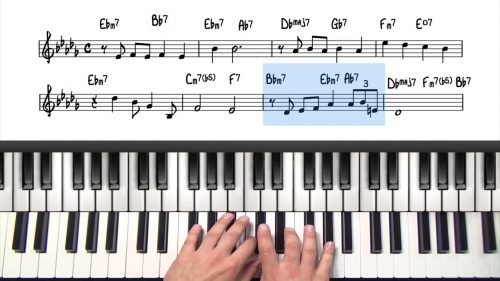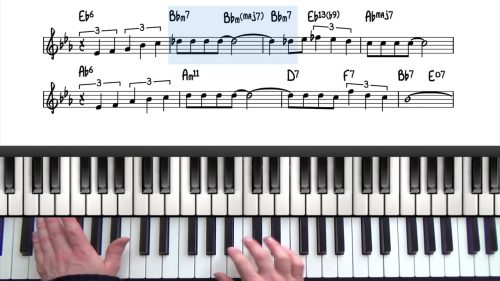Advanced Tritone Substitution Tutorial
In this lesson we are going to look at various ways to add harmonic interest over dominant chords using tritones. Before watching this lesson, you should check out the introduction lesson on Tritone Substitution.
This lesson will give you a strong understanding of the concepts behind tritone substitution we also analyse specific applications in a few popular jazz standards.
The examples covered in this lesson are more advanced and also incorporate the theory from upper structure triads. If you are not comfortable with upper structures, it would be good to watch those lessons before diving into this one.
When we have a dominant chord, something I like to do is play a 13sus4 chord for the dominant chord and then play an upper structure triad over of the tritone of the original dominant.
This works well because the sus chord has an unresolved nature indicating it wants to move somewhere and that is exactly what happens — we move to an upper structure of the tritone which means we are still playing the same 3rd and 7th but with different colours on top from the extensions & alterations.
Practice Tips
-
The first step is to use the circle of fifths and play through each of the 12 keys. Play the root in your left hand, and a rootless voicing in your right hand.
-
First, play the 251 with root of the V Chord, and then play the same voicings in your right but change the bass note to the b2 or the tritone substitute
-
Next, it's time to apply this theory to jazz standards.
-
The first step is to learn the examples covered in the lesson. Then you can work out your own tritone substitutes.
-
Look through the jazz standards you are playing, and spot any major 251s.
- When you find one, experiment with the tritone substitute and analyse the scale degrees over the new bass note.







Hi! First of all, thanks for all the interesting lessons you are providing me! :)
Anyway, a question about the sequence of dominant 7th. At the end I was expecting E7 11# with un upper structure that resolve on Eb maj7. Instead I see another Eb, but obiously dominant 7th and it works very good, but why? :)
Can you give me a short explanation? Thanks in advance ;)
Bye.
Hello Hayden: the part of this lesson focusing on Body and Soul is of great deal of use to me as an intro (Lyndol also suggests the same or very, very similar intro in her relevant lesson). Now I have all the pieces to play the tune as a ballad, rubato. However, I cannot find on Youtube a recording with a piano improvisation that is not too difficult to copy, emulate, mimic…etc. Any suggestions for such a video? My improvisational skills are still rudimentary but for some reasons this tune ‘speaks to me’ and that motivation will help develop some kind of improvising at a slow tempo.
Or any other suggestion you may have to help me start improvising on this tune.
Thanks ahead of time. Smole
P.S. I went through all the courses and lessons within the PG domain on the issue of interpretation. My question related to a specific video(s) where I find and learn an improvisation, if possible.
Hi Smole,
Apologies for the late reply, I’ve been on the road and working with our teachers.
This tune is rather complex harmonically and moves through many keys. The A Sections are in Db Major, and then the Bridge modulates to D Major then to C Major before returning to the final A Section.
This can make it a challenging tune to improvise over because the tonal centre of the harmony is constantly changing. Tunes with less modulations are certainly easier candidates to start off improvising over.
Don’t let this put you off, but just a heads up.
Some things I would recommend before attempting to improvise over it:
1) Memorise the chords and melody so you don’t need the lead sheet in front of you. This is very important.
2) It’s an AABA form so understand that once you have memorised first 8 bars, you have actually memorised 75% of the tune.
3) Spend a lot of time working on the bridge and memorising those chords. The bridge only constitutes 25% of the harmony, and so if you are always playing though from start to finish, then those 8 bars will naturally be weaker than the rest of the tune. Perhaps spend some days just working on the bridge and memorising it inside out.
4) If you want to play the tune solo piano, then a left hand stride style would be nice and perhaps sprinkle in some left hand voicings here and there, particularly where there are multiple chords per measure.
5) Practice just your left hand with a metronome until your left hand is on auto-pilot, ie. you are not having to overly think about the voicings you are playing.
6) Listen, Listen, Listen, and transcribe. The goal would be to transcribe multiple full solos. It doesn’t have to just be piano players… any instrument can be great for inspiration.
Have you checked out Spotify? There are many recordings on there.
I also use the “Amazing Slow Downer” app, more info on that here: pianogroove.com/community/t/the-amazing-slow-downer/2682 – it integrates directly with Spotify and will be very useful for you.
Regarding your last question, improvisation comes from within, it can only truly be learnt from listening and transcription, we have videos addressing some improvisation concepts, but I’d recommend that you ‘go straight to the source’ by listening and transcribing.
I will spend some time over the next few days listening to lots of recordings of Body & Soul and then I’ll send you my recommendations for transcription.
Talk soon!
Hayden
Thank you, Hayden, for your usual detailed response; that is always greatly welcome.I have been working/drilling the Body and Soul tune for weeks because of its challenging harmonies and the key (Db that requires using black keys on the keyboard a lot, a problem for me). I have mostly done what you suggested but I need to work on your suggestion no. 5. The tune somehow moves me to play it in a slow rhythm that simply calls for the stride-style accompaniment so that is what I have been focusing on. I signed up for Spotify but on a first try did not see anything there that is not on Youtube that I believe I checked thoroughly. Please do not worry and/or invest any more of you time on looking over various performances of the tune; I thought that maybe something will occur to you quickly based on your vast experience. As it is, I will continue getting ideas (beyond your lessons on this tune) for more extensive interpretation….if that turns out to be reasonable, ‘doable’, etc. Thank you again. Best, Smole
The cycle of 13 sus and the tritones sounds really awful to my ears.